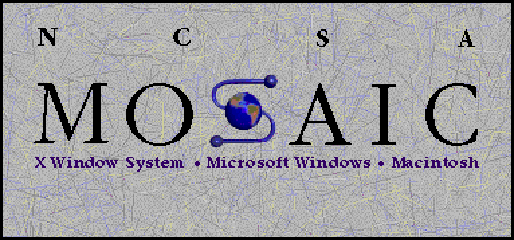Beginnings
at the University of Illinois
Marc
Andreesen was a student and part-time assistant at the Nationa l
Center for Supercomputing Applications (NCSA) at the University of
Illinois when the World Wide Web began to take off. His position at
NCSA allowed him to become very familiar with the Internet. Like just
about everyone else who was involved with the Internet, he also became
familiar with the Web. Most of the browsers available then were for
Unix machines which were expensive. This meant that the Web was mostly
used by academics and engineers who had access to such machines. The
user-interfaces of available browsers also tended to be not very user-friendly,
which also hindered the spread of the Web. Marc decided to develop
a browser that was easier to use and more graphically rich.
l
Center for Supercomputing Applications (NCSA) at the University of
Illinois when the World Wide Web began to take off. His position at
NCSA allowed him to become very familiar with the Internet. Like just
about everyone else who was involved with the Internet, he also became
familiar with the Web. Most of the browsers available then were for
Unix machines which were expensive. This meant that the Web was mostly
used by academics and engineers who had access to such machines. The
user-interfaces of available browsers also tended to be not very user-friendly,
which also hindered the spread of the Web. Marc decided to develop
a browser that was easier to use and more graphically rich.
In 1992, Andreesen recruited fellow NCSA employee, Eric Bina, to help
with his project. The two worked tirelessly. Bina remembers that they
would 'work three to four days straight, then crash for about a day'
(Reid, 7). They called their new
browser Mosaic. It was much more sophisticated graphically than other
browsers of the time. Like other browsers it was designed to display
HTML documents, but new formatting tags like "center" were included.
Especially
important was the inclusion of the "image" tag which allowed to include
images on web pages. Earlier browsers allowed the viewing of pictures,
but only as separate files. Mosaic made it possible for images and
text to appear on the same page. Mosaic also sported a graphical interface
with clickable buttons that let users navigate easily and controls
that let users scroll through text with ease. Another innovative feature
was the hyper-link. In earlier browsers hypertext links had reference
numbers that the user typed in to navigate to the linked document.
Hyper-links allowed the user to simply click on a link to retrieve
a document.
In
early 1993, Mosaic was posted for download on NCSA's servers. It was
immediately popular. Within weeks tens of thousands of people had
downloaded the software. The original version was for Unix. Andreesen
and Bina quickly put together a team to develop PC and Mac versions,
which were released in the late spring of the same year. With Mosaic
now available for more popular platforms, its popularity skyrocketed.
More users meant a bigger Web audience. The bigger audiences spurred
the creation of new content, which in turn further increased the audience
on the Web and so on. As the number of users on the Web increased,
the browser of choice was Mosaic so its distribution increased accordingly.

By
December 1993, Mosaic's growth was so great that it made the front
page of the New York Times business section. The article concluded
that Mosaic was perhaps "an application program so different and so
obviously useful that it can create a new industry from scratch" (Reid,
17). NCSA administrators were quoted in the article, but there
was no mention of either Andreesen or Bina. Marc realized that when
he was through with his studies NCSA would take over Mosaic for themselves.
So when he graduated in December 1993, he left and moved to Silicon
Valley in California.
Netscape
Andreesen
settled in Palo Alto, and soon met Jim Clark. Clark had founded Silicon
Graphics, Inc. He had money and connections. The two began talking
about a possible new start-up company. Others were brought into the
discussions and it was decided that they would start an Internet company.
Marc contacted old friends still working for NCSA and enticed a group
of them to come be the engineering team for the new company. In mid-1994,
Mosaic Communications Corp. was officially incorporated in Mountain
View, California. Andreesen became the Vice President of Technology
of the new company.
The
new team's mandate was to create a product to surpass the original
Mosaic. They had to start from scratch. The original had been created
on university time with university money and so belonged exclusively
to the university. The team worked furiously. One employee recalls,
" a lot of times, people were there straight forty-eight hours, just
coding. I've never seen anything like it, in terms of honest-to-God,
no BS, human endurance, to sit in front of a monitor and program.
But they were driven by this vision [of beating the original Mosaic]"
(Reid, 27).
The
new product would need a name. Eventually, the name Netscape was adopted.
It would also need a price structure. At first, a plan to charge $99
for the browser, $5,000 for the basic server, and $25,000 for the
commercial server (which included Secure Socket Layer Technology,
or SSL, and could encrypt sensitive information such as credit card
numbers) was considered. It was then decided to charge $1,500 for
the baseline server and $5,000 for the commercial server.
Pricing
for the browser was a complex question. Andreesen and others new that
the key to success would be making Netscape ubiquitous on the Web.
Andreesen recalls:
"That was the way to
get the company jump-started, because that just gives you essentially
a broad platform to build off of. It's basically a Microsoft lesson,
right? If you get ubiquity, you have a lot of options, a lot of
ways to benefit from that. You can get paid by the product you are
ubiquitous on, but you can also get paid on products that benefit
as a result. One of the fundamental lessons is that market share
now equals revenue later, and if you don't have market share now,
you are not going to have revenue later. Another fundamental lesson
is that whoever gets the volume does win in the end. Just plain
wins." (Reid, 31).
They
decided to adopt a "free but not free" price structure for the browser.
It would be free for students and educators; $39 for everybody else.
In reality, nearly everyone had free access when Netscape was released.
Beta versions were available for free, and new beta versions came
out often. The current versions could also be downloaded and tried
for free for 90 days. The trial period was never really enforced,
however, and so many got Netscape for free that way. There was also
a version that consumers could mail order which provided some income.
Andreesen and the others did not worry so much about making money
selling the browser. If everyone was using it, they could make money
in other ways such as selling advertising on their home page.
On
October 13, 1994, Mosaic Netscape was posted for download on the Internet.
Within weeks it was the browser of choice for the majority of Web
users. It included new HTML tags that allowed Web designers greater
control and creativity. Excited designers quickly began incorporating
the new tags into their pages. The new tags could only be read by
Netscape, so the designers would usually include a note that their
pages were best viewed with Netscape and a link to the page where
it could be downloaded. This was great advertising for Netscape. It
also further grew the Web itself because Web pages became more exciting.
There
was one major problem facing Mosaic. The University of Illinois claimed
that Mosaic Netscape had stolen Mosaic from them and demanded they
change their name and quit distributing their product. Mosaic changed
their name to Netscape Communications Corporation., but refused to
quit distributing their software. On December 21, 1994, an agreement
was reached. The University of Illinois made no further claims on
Netscape and received a financial settlement. The settlement plus
legal expense cost Netscape close to $3 million (Berners-Lee,
93). More good news had come just six days earlier when the shipping
versions of Netscape were ready for distribution, which brought in
some actual income.
What
happened to Netscape?
Perhaps
as much can be learned from Netscape's downfall as from  its
meteoric rise to the top. By 1996, 75% of Web users used Netscape.
Now Netscape is merely a subsidiary of America Online and has only
a third of the Web's users. Microsoft Internet Explorer has replaced
Netscape as browser number one.
its
meteoric rise to the top. By 1996, 75% of Web users used Netscape.
Now Netscape is merely a subsidiary of America Online and has only
a third of the Web's users. Microsoft Internet Explorer has replaced
Netscape as browser number one.
What
happened? Surely, part of the reason for the dramatic change of fortune
for Netscape is that Microsoft is simply too strong a competitor (ongoing
legal battles will determine whether they are actually a monopoly).
But some believe bad management at Netscape also contributed to its
downfall. They point to a 'Just show up' strategy for success (Powell,
64). Netscape management saw its product as superior and looking
at its huge share of the market rested on their laurels to some degree.
Over time, Internet Explorer became the more reliable browser with
better features. Netscape continued to charge for its product and
its pricing structure continually changed and was inconsistent while
Internet Explorer has always been totally free.
By 1999, Netscape was battle-weary and America Online bought it for
$10 billion in stock. America Online does not use Navigator as its
official browser. It does not seem interested in Netscape software,
but rather in converting the remaining Netscape audience into its
own. The new marketplace of the World Wide Web is a very volatile
and dynamic one. Getting to the top is difficult, but staying there
is even harder. In an environment that changes so rapidly it would
seem that competitors too would have to be willing and able to change
continuously.

Home|
Vannevar Bush | J.C.R.
Licklider | Larry Roberts | Paul
Baran |
Bob Metcalfe |
Doug Engelbart | Vint Cerf | Ted
Nelson | Tim Berners-Lee |
Marc Andreesen | Epilogue |
References |